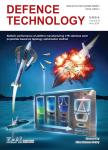Biotransformation and degradation of 2,4,6-trinitrotoluene by microbial metabolism and their interaction
Biotransformation and degradation of 2,4,6-trinitrotoluene by microbial metabolism and their interaction作者机构:Tecnologico de MonterreySchool of Engineering and ScienceCampus MonterreyAve.Eugenio Garza Sada 2501MonterreyN.L.CP 64849Mexico
出 版 物:《Defence Technology(防务技术)》 (Defence Technology)
年 卷 期:2018年第14卷第2期
页 面:151-164页
核心收录:
学科分类:08[工学] 0826[工学-兵器科学与技术]
基 金:the Director of the School of Engineering and Science, Tecnológico de Monterrey, Campus Monterrey for his encouragement and financial support the financial support from CONACYT(Mexico)PhD scholarship No. 309171 for CCZ, SNI-C fellowship to RC and MR, FR Aavesh green sustainability solutions S. De R. L. De. C. V. for their support
主 题:Laccases Aerobic degradation Anaerobic degradation Fungal TNT degradation
摘 要:2,4,6-trinitrotoluene(TNT) and its derivatives are nitrogen-containing aromatic compounds having chemical and thermal stability at ambient temperature and pressure. TNT has high toxicity and mutagenic activity to humans, plants and animals, thus decontamination processes are necessary. Many microorganisms are capable to bioremediate TNT such as bacteria from the genera Pseudomonas,Enterobacter, Rhodococcus, Mycobacterium, Clostridium and Desulfovibrio: fungus such as Phanerochate and Stropharia species are able to perform TNT biotransformation under aerobic and anaerobic conditions. In this work we review the state of TNT biodegradation by various routes: aerobic, anaerobic,combined, fungal, enzymatic, and bio-electrochemical.



